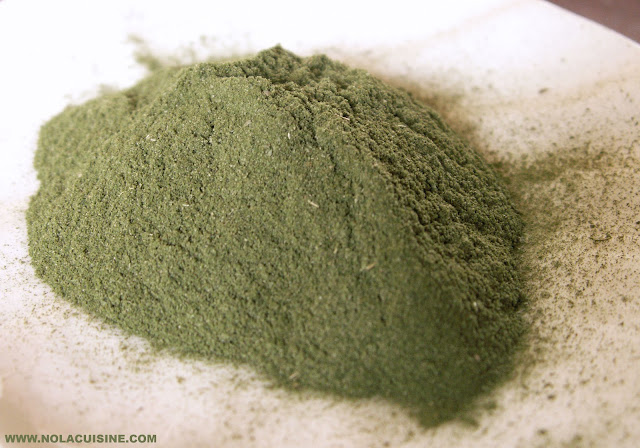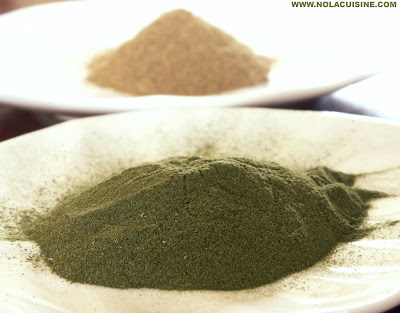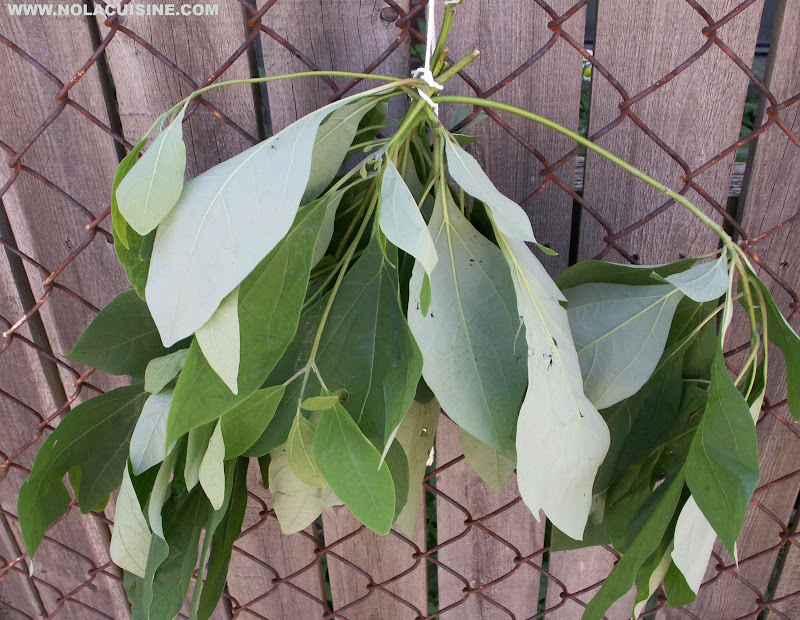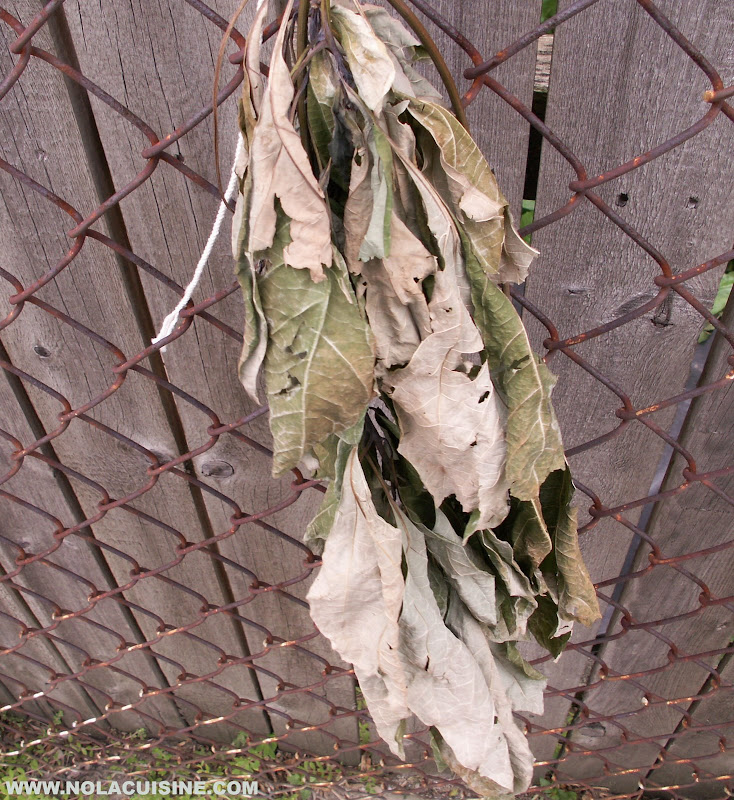 |
| From Nola Cuisine |
I finally made a small batch of homemade Filé Powder, and I can’t believe the difference between the true Filé and the store bought variety.
The Filé that I made smells subtle and fruity like coriander seeds, or as my wife said, “Fruit Loops.” It’s color as you can see, is army green, and I’m assuming that it’s thickening power is way more intense than the store bought, which I’ve noticed has zero thickening power at all, and has a flavor that can almost take over the flavor of your Gumbo.
The store bought Filé smells very woodsy, and you can detect some thyme and possibly some bay leaf in there, it’s color is tan. One that I saw recently contained Sage, Oregano, and Thyme, and no Sassafras at all. There are definately some good ones out there, but definately some really bad ones. For example, here is a picture of the two side by side, the store bought is in the background, my homemade is in the foreground:
 |
| From Nola Cuisine |
The following is from the 1978 book Creole Gumbo and All That Jazz by Howard Mitcham:
The Story of Filé
For hundreds of years the Choctaw Indians have had a settlement at Bayou Lacombe on the North Shore of Lake Pontchartrain, and they had a way of making Gumbo long before the white man and the black man arrived. They invented filé (pronounced feelay). The tender green leaves of the sassafras tree are gathered, dried, and ground to a powder. Only a few tablespoons of the powder will thicken a whole pot of Gumbo and give it a flavor that’s spicy and pleasant. The filé must always be added after the pot is removed from the fire. If allowed to boil, it becomes stringy and unpalatable. Okra and filé should never be used together in a Gumbo or it will be as thick as mud. The Creoles in New Orleans used filé only in the wintertime, when fresh okra was not available but many Cajuns prefer filé gumbo year-round. They pass a big bowl of filé around at the table, so that all the guests may take as much as they want.
The Indians also supplied dried bay leaves (laurel), an essential flavoring element in most Creole soups and stews. At the old French Market there were always several Choctaws sitting in the shade of the arcade, peddling their small caches of filé and dried bundles of bay leaves.
On several visits to Bayou Lacombe a few years ago I was fortunate enough to meet one of the last of those Indian filé makers. His name was Nick Ducre, and he was over eighty-five, very proud, wise and independent. He owned a few acres of very valuable land on the banks of the bayou. Rich folks had built up bayou estates all around him, but he clung to his land and kept it in a primitive state with plenty of game-coons, possums, squirrels, rabbits, and even a few deer. A great story teller, he told us much about the good old days in the early part of the century. Once a month he would take a schooner across the lake to New Orleans and sell his filé and bay leaves at the market at the New Basin Canal. He would sell out in one day, buy himself a pint of whiskey, and sail for home that night, a happy Indian.
At our last parting Nick gave me a sample jar of his homemade filé, and I made a pot of gumbo with part of it. Because I didn’t realize just how strong it was, I overdid it. That gumbo got so thick, the stirring spoon stood upright in it. I have saved the rest of that filé as a memento of one of the best Indians I ever knew.
So whenever you eat gumbo filé, give a thought to the almost vanished Choctaws of Lacombe. filé of a commercial grade can be purchased at any grocery store in New Orleans and in the Cajun country, but the homemade kind is stronger and tastier. If you can’t find an Indian source, you can make it yourself by pounding dried sassafras leaves with pestle and mortar. And while you’re at it, pound up a few bay leaves for a terrific flavoring element.
The Choctaws and their Filé are long gone from the French Market, which is now little more than a tourist trap to purchase Mardi Gras beads, T-shirts, and a million varieties of hot sauce. It’s still a must stop though, if just to feel the history of the old French Market.
Here is a quote from Leah Chase regarding Filé from the 1978 publication Creole Feast by Nathaniel Burton & Rudy Lombard:
I don’t buy the filé powder for my gumbo off the shelves. My daddy makes it for me. He grinds it himself and it is perfect because it is pure sassafras. He has sassafras trees and he dries the leaves. The filé from a store will have maybe a little bay leaf in it and it’s much weaker. Mine is pure sassafras, nothing mixed in, and it’s always fresh and strong. Daddy sends it to me in little mayonnaise bottles.
 |
| From Nola Cuisine |
How to make homemade Filé Powder
Locate a Sassafras tree and take some branches containing the younger, more tender leaves.
 |
| From Nola Cuisine |
Hang the branches outside to dry (preferably out of the direct sun) for about one week.
 |
| From Nola Cuisine |
 |
| From Nola Cuisine |
When the leaves are completely dry, remove the leaves from the stems and pulverize very well in a mortar and pestle, or an electric coffee grinder as I did.
Pass the powder through a very fine sieve, or a metal coned coffee filter as I did. It was a painstaking process as the mesh was too fine, but it worked to remove all of the little twigs, and tough pieces.
Store in an airtight container and keep out of the sunlight.
I feel a Filé Gumbo in Nola Cuisine’s very near future, I will keep you posted.
**Update** I recently noticed a container of Tony Chachere’s File powder at the store and picked some up. It’s the real deal, pure Sassafras, just like my homemade. Highly recommended!
Be sure and check out my ever growing Index of Creole & Cajun Recipes which provides links to all of the recipes featured on this site!

Good show, Danno !!!! Some things cannot ever be forgotton. I can see ole Danno paddling his pirouge up to the French Market and setting up his File’ stand. We need more of that.
if you can’t find a sassafras tree (go past slidell over the state line into mississippi, good ones can be found there), head down to Venice. look for real file on tables at some of the local restauarants (uh, there’s not very many and they are not fancy. ask them if miss muriel made the file. if she did, convince them to sell/give to you. it’s the real deal (miss muriel is the one who told me about where to pick leaves in mississippi). and if you treat it right (the no sunlight/ airtight, it will stay fresh for a very, very long time never lose that beautiful green color. you’ll never eat that brown stuff again.
I have many, many sassafras’ trees available, love the thickness of okra and sassafras. I want a true gumbo recipe. I am using chicken, italian sausage, shrimp, tomatoes, a roux made with flour, butter, seafood broth (made from boiling the shrimp shells), onions, garlic, bay leaves, salt, pepper. It is wonderful…Is sassafras toxic in any way?…Also “laurel” mentioned…is that toxic. We had several varieties of “laurel” available and also it is called “mountain laurel”….called “mauntain ivy”….does eat oats and little lambs eat ivy…same thing?..
you could just buy zatarans pure file. its just sassafras root. that other shit isnt file. file isnt brown. they sell that shit up north to people who have no idea what they’re buying.
Adam – sometimes it’s about learning how to make something yourself. By the way, File is dried Sassafras leaves, not root.
Thank you for this information. I fully intend to make the most insane gumbo using nice sassafras file for a very special lady. Your blog was a big help.
question,,my mom came across a plastic bag in basement containing some sassafras roots she dug about 12 years ago,they are clean,no mold, smell good though a little weak .i geuss its good ,and safe, is there a chance of it being unsafe to make tea from it?
Pick the leaves befor the firstcold snap. My grandfather always harvested his leaved the last full moon in August. The nutients are still in the leaves. I hang the branches to dry in an old shed, and at Thanksgiving, when we all get together in Louisiana, we clean out the twigs, crumble the leaves by hand, picking out the leaf stems. Then we use a spice mill to grind them, and a strainer to remove the pieces. All that is left is the fine powder, and the best Filé we can get. No one really expects to get rich on this, but we do it for tradition, and really enjoy the making as much as the eating of it.
If a tree is not near, replant it before spring in the new location, before the budding begins, while it is still dormant. Usually you can find a few younger plants near the older, as the roots run, and offshoots develop.
it`s great to hear all this file` talk,this is somthing some folks will love to hear.via: tony cachere…
you want some real file` then you harvest it on the full moon of august…….
Before you go chowing on the roots, check out the wikipedia article on them. Jest say they’re no FDA approved!
do you sell your file….I sure need some!!
Is there any place in the Boston,Ma. area that I can get any Gumbo file. My father was from Villi Platt area.
Gerry Fontenot
Gerry,
Sassafras grows in Mass. take a walk in a state park and grind your own. Look at wikipedia for a picture to identify leaves, you can’t mistake it. Up here in the North the trees only grow about 10 feet max, more like a shrub. The 3″ diameter trunks are usually twisted or gnarly.
The leaves are not toxic or carcinogenic. The root bark is used to make sassafras tea. The root contains safrole which has been shown to cause cancer in the livers of mice. Safrole is also a precursor to the illicit drug “Ecstasy”. They don’t collect sassafras to make the drug..they use synthetic safrole.
I HAVE A TON OF SASAFRASS TREES ON MY PROPERTY AND I’M GONNA TRY THIS AT MY EARLIEST CHANCE!!!
I brought back a supply from my only trip to New Orleans from Alberta Canada and I have recently run out. I am hoping to find a source. I am pretty sure that what I bought was the real McCoy because of its color and the fact that it was bought on a Plantation tour. I won’t be able to make my gumbo until I can replenish my non-existent supply. The okra we get is not my ‘cup of tea’ so can anyone help???
I was tearing down a fence a few days ago and found three sassafras trees. I just made some file. This is the best I’ve ever had
You can find Filé here.
http://www.cajunspice.com/seasoning/
Gerry, I have lots of sassafrass leaves in my Plymouth, ma yard. If you send me an address, I’ll mail you some and you can make your own!
*sigh* How do I find a sassafrass tree here in Arizona?
Definately times I miss being home in Louisiana.
Jerry
Danno, People must take FDA warnings about chemical contents with a grain of salt. They tend to slant things toward the medical community and away from traditional practices. The Safronole used in experiment is pure and without the synergistic compounds in the leaves. Furthermore as they did with sacchrine they give the rats enough to to equal humans eating 2000 trees. Its all about the money… Jay
The reasoning behind the FDA warnings concerning safrole has nothing to do with cancer and everything to do with the use of safrole in the production of MDMA. Unfortunately for you traditionalists, this is not an unommon practice. The same sorts of things were done to ban ephedrine and pseudoephedrine to derail the production of methamphetamines. Even though those two compounds are generally safe if taken reasonably and without other supplements, they were banned. Take this to heart; Tylenol killed more people (acetominophen) that year then sudafed. Unfortunately for the US Government, so many natural compounds (nutmeg, bay, dill, the list goes on forever) are also used in the production of illicit compounds. Just so you know….Yes, the above poster is correct, the amount of safrole pumped into those rats was the equivalent of a human eating the dried roots of several sassy tress. Pretty ridiculous if you ask me, Uncle Sam just could have been honest instead of trumping the “cancer” card.
I believe that “laurel” is bay leaves. At least, in Spanish it is; bay leaves are called “hojas de laurel.” (reply to Linda, Feb 12 2007)
I read with interest your comments about Nick. It is interesting that Nick that was a brother to my grandfather Will, a brother to my uncles Amedee, Tucker, Prosper and others. None of them were Indians but the stories about Nick persist. Does anyone know how far it is from LaCombe to New Orleans? Daily trips by schooner to New Orleans? Are you kidding?
At least the comments about file and how it is made are accurate.
Hannah- Thanks for your comment. The information about Nick Ducree is an excerpt from the book Creole Gumbo & All that Jazz by Howard Mitcham.
I can see it as very plausible that the author assumed that Nick was an “Indian” because he was selling File, maybe fantasy and folklore got the better of him.
I suppose there must be some truth to the story though. He doesn’t really give many specifics on what part of the lake he was crossing from and he never says that he traveled from Lacombe, just across the lake. Do you know where the market on the New Basin Canal is/was? Any ideas? By the way, he doesn’t say everyday, but once a month.
It’s amazing how quickly details of a story can be misconstrued, imagine the details that may been accidentally changed over the years. Thanks again for your comment!
Question, I have never dried any plants or herbs, but I thought some were to be dried hanging down and others hanging upright. You mention hanging young limbs to dry. Is that hanging them down or up, or does it even matter in this instance?
can you tell me if there are any of the choctaw indians around the city. i am from west coast but have choctaw indian in my heritage.
Thanks for such great pictures. I just received some Sassafras leaves and wouldn’t you know it…my dehydrator broke so I’ve got them in the oven on warm to dry. This will be my first time to grind my own file`. We’re going to plant some trees so hopefully we’ll have our own crop to harvest in a couple of years. Thanks again!
tony c. says the real deal is picked on the full moon of august
and dried than powdered up. i`ve been doing that for years and
it`s ya-ya…….
My father was born in Alabama, and his maternal grandmother was from New Orleans. When my father was four, the family moved out to California, where I was born and grew up. But we grew up with our Southern traditional cooking, and our Christmas turkey always ended up in a gumbo, made the day after. My grandmother passed on to my mother the secret of a good gumbo. “Always add the file after you take it off the boil”, and the file was the essential part of the gumbo. There was no gumbo in our house without the file. Locating the file is getting more and more difficult, so it’s great to be able to know how to make your own! Thanks
I am in Alabama, I have never saw a sassafras tree to my knowledge, I sure would like to get a tree, if any of you that have trees have small ones comming up around it and would help me my sending a few of the sprouts, I would be glad to pay what you need for your trouble, and postage.
Thank you
Charlotte Johnson
I am in Alabama, I have never saw a sassafras tree to my knowledge, I sure would like to get a tree, if any of you that have trees have small ones coming up around it and would help me by sending a few of the rooted sprouts, I would be glad to pay what you need for your trouble, and postage.
Thank you
Charlotte Johnson
I dried some sasafrass in a dhydrator. Will this work the same as hanging outside? We have had so much rain that I don’t think anything would dry outside here. I am in North Louisiana and have loads of the trees on my property. I am trying to learn some of the lost arts such as this one, so that I can pass them on to my grandchildren.
have seen lots of potential file/sassafras trees at state park campsites in DE; didn’t know the culinary value as an aspiring gumbo cooker. Thanks for the advice!
Are there any sassafras trees in Texas? I live near Houston, Texas now and would love to make my own file for my gumbo.
TO CHARLOTTE JOHNSON:
DID YOU FIND ANY SASSAFRASS. I LIVE IN CENTRAL AL AND IT IS COMMON HERE. I MAY BE ABLE TO HELP YOU FIND SOME 205-755-0666. iT HAS BEEN AWHILE SINCE YOU POSTED SO YOU MAY NOT NEED ANY NOW
LEE ROY.
Anyone willing to part with some Sassafrass leaves? I live in Minnesota, but love to cook Creole?
This is first I have ever heard of “file”. I will do some research on it. I live in VA, maybe that’s why? Information was very helpful though.
Now I know what to do with those sassafrass leaves! Thanks for all the enlightening info!
In NY (on Long Island) sassafras trees grow like weeds, and can easily reach 50 feet or more. They are an “understory” tree, and grow in the shade of other trees. Its not uncommon to see a bare 40 foot trunk, with leaves only at the top, as the tree reaches for sunlight.
Hey wow I am from the Bayou Country where they speak Cajun French and just now for the first time looked up what is in Filee. My Grand mother used to make the best Chicken Gumbo and used fresh Okra that my Grand Father used to grow in his little garden mostly Okra, as a child I thought why does he grow this stuff that is like snot when boiled, but in Gumbo with Filee it’s the best.
Thanks again now to find a tree, I live out in the California desert now near Joshua Tree. May be able to sell it out here there are artists and culinary folks that would appreciate the real deal. There is stuff that they take out of the Sassafras for Root-beer flavor safrole I believe it is that was supposed to be bad for you now I am thinking they use the stuff to synthesize other compounds with worth more money, and used the extraction to protect the public as an excuse to take the stuff out.
That may be why the Filee in the store is substandard it has extracted leaves or no Sassafras in it at all.
Sasafras oil comes from a byproduct of Camphor in China, that does not sound good at all, and the Safrole from essential oil of the real Sasafras can be used in clandestine manufacture of MDMA a weird drug. Are the big Pharmas taking it to make things or is the Government really trying to protect us. Some of the things in Camphor that if not seperated can cause epileptic fits, they get the Sasfras oil from that is sold (is from China no less), so you tell me what is really going on with that. I will call it the “Root-Beer Conspiracy”.
I’m from Pennsylvania and we have green bark and red bark varieties. I know the red bark variety has the best tasting roots for tea. Does anyone know if there’s a difference when it comes to the leaves?
Can anyone tell me how to use sassy trees to make tea and root beer? My husband has the making of file down to a science! But I am interested on tea and root beer recipes. thanks from Houma, Louisiana
Homemade Sassafras Root Beer Recipe
Several roots (including some green stems) from sassafras saplings, about 30-40 inches worth of 1/4-inch thick roots (enough to fill one cup when you chop them into 1/2-inch pieces)
4 cups water
2 cloves
1/2 teaspoon anise seeds (can sub fennel)
4 allspice berries
1-inch of stick cinnamon
1/4 cup molasses
1 cup sugar
2 quarts soda water
1 Scrub the roots clean of any dirt. Cut the roots into 1/2-inch long pieces. (The roots can be tough, if you have a pair of pruning shears, they work great to cut the roots.) If you have a few green stems, you can include them too, but you should have mostly roots. Cut up as much as you need to fill one cup. Put the roots into a small pot and cover with 4 cups of water. Add the cloves, anise seeds, allspice berries, and cinnamon stick. Bring to a boil, reduce to a simmer, and simmer for 25 minutes. Add the molasses and simmer for 5 minutes more. Remove from heat.
2 Strain through cheesecloth or a fine mesh sieve lined with a paper towel. Rinse out the pot. Return the liquid to the pot. Add the sugar, heat until just a simmer and the sugar has dissolved. Remove from the heat and let cool.
3 To assemble the root beer, fill a glass with ice cubes, add the syrup and soda water in a 1:2 ratio, so 1/3 cup of syrup to 2/3 cups of soda water. Add more soda water if you want it more diluted, add more syrup if you want it stronger.
I’m sitting here in my SW Missouri office, only a window and a wall seperating me from the volunteer sassafras that took root last year. I didn’t realize what it was until this spring. Now, waiting for autumn to remove it as it’s too close to the building. The File recipe makes me want to transplant it and keep it for years, my knowledge of invasive growth does not. Thanks for the File recipe! Either way, the tree will have a place in my spice cabinet!